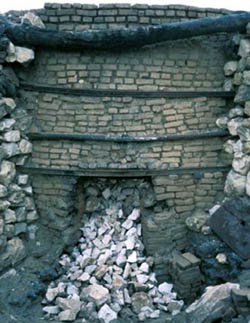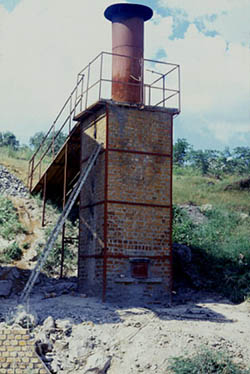How to Calculate the Energy Efficiency of your Lime Burning Process
Contents
Short Description
- Problem: Calculate Energy Efficiency of Lime Burning Process
- Information Type: Principles
Introduction
The practice of burning limestone to produce quicklime is, almost literally, as old as the hills. In terms of basic chemistry and materials, the process involves the conversion of calcium carbonate, CaCO3, to the more useful calcium oxide, CaO. Calcium oxide is a very reactive substance. In fact, it is so 'lively' that it is usually hydrated (has water added) to form calcium hydroxide, Ca(OH)2. Calcium hydroxide is commonly called hydrated or slaked lime, and sometimes merely lime - which can be confusing as powdered limestone is often referred to in the same way. Hydrated lime is a more convenient material to handle and use than quicklime. Quicklime and hydrated lime have a very wide - and well documented - variety of uses.
This conversion of calcium carbonate to calcium oxide is achieved by heating the limestone to a temperature high enough (e.g. 1000°C in a lime kiln) to 'drive off' carbon dioxide, CO2. The equation for this process, with the approximate molecular weights, is:
|
Types of limestone Calcite is a limestone which contains only calcium carbonate, CaCO3. There are other types of limestone which are of interest. Dolomite has the chemical formula CaCO3.MgCO3, i.e. it is a 'mixture' of calcium and magnesium carbonates in the proportion 1:1 of their molecules. Dolomitic limestones are those which contain some proportion of dolomite. Similarly, quicklime and hydrated lime may contain oxides and hydroxides of magnesium as well as of calcium. |
Continuing the approximation for hydration gives:
So, in simple terms, if the process were carried out with 1 tonne of limestone which was pure calcium carbonate, it should produce 560 kg of quicklime. And if 180 kg (approximately 180 litres) of water were added to this quicklime, then 740 kg of calcium hydroxide should result.
Some limestones are dolomitic, that is they contain the mineral dolomite, CaCO3MgCO3, in addition to the CaCO3 which is present as the mineral calcite. Usually, pure calcitic limestones are preferable but dolomite can be tolerated provided the quicklime is well slaked before use.

Figure 1: A traditional lime kiln in Sudan @ Simon Croxton/Practical Action
Efficiency of lime burning
Lime burners are generally seeking to produce the highest quality quicklime possible from their stone whilst keeping their production costs to a minimum. In the majority of cases, a very major production cost will be the fuel used. Thus, the efficiency of the burning process (as opposed to the whole process of production which will involve labour costs etc.) is judged by how much fuel it takes to produce a quantity of quicklime. For instance, a limeburner may say “I produced X tonnes of quicklime using Y tonnes of coal which cost me Z dollarsâ€. However, in order to compare different types of kilns using various fuels and producing quicklime of variable quality, it is necessary to develop a more universal measure of efficiency.

Figure 2: An improved vertical shaft kiln in Zimbabwe ©Kelvin Mason / Practical Action
Kiln or burning efficiency can be determined and compared using the formula for thermal efficiency proposed by Robert Boynton, former director of the National Lime Association in the USA, in his book ‘Chemistry and Technology of Lime and Limestone’:
![]()
This can be presented mathematically by the efficiency equation:
Where
|
E |
= |
Efficiency of the burning process |
|
Hc |
= |
Theoretical heat of calcination per tonne for pure quicklime, CaO plus MgO (MJ/tonne) |
|
Ls |
= |
Available lime content (as CaO and MgO) of the quicklime |
|
Cf |
= |
Calorific value of fuel (MJ/kg) |
|
Mf |
= |
Mass of fuel used per tonne of quicklime (kg/tonne) |
NB: Take care when using this formula that the units used are as specified or, if different units are used, that mathematical consistency is maintained.
Explanation and derivation of terms
Hc
For all practical purposes, this can be taken as 3,200 MJ/tonne CaO for a pure calcite limestone. For a pure dolomite limestone the figure is lower at 3,020 MJ. It is reasonably straight forward to adjust the figure for 'dolomitic' limestones as follows in the example.
From a test on limestone the following chemical analysis was obtained:
|
Table 1: Chemical analysis obtained on limestone (%) | |
|
Silicon oxide, SiO2 |
2.03% |
|
Aluminium Oxide, Al2O3 |
0.67% |
|
Iron Oxide, Fe2O3 |
0.33% |
|
Calcium Oxide, CaO |
45.50% |
|
Magnesium Oxide MgO |
8.16% |
|
Sulphuric Anhydride, SO3 |
0.39% |
|
LOI (at 1,000°C) |
42.40% |
A test on the quicklime produced the following result:
|
Table 2: Chemical analysis obtained on limestone (%) | |
|
Silicon oxide, SiO2 |
2.34%, |
|
Aluminium Oxide, Al2O3 |
0.63, |
|
Iron Oxide, Fe2O3 |
0.35%, |
|
Calcium Oxide, CaO |
68.40%, |
|
Magnesium Oxide MgO |
17.8%, |
|
Sulphuric Anhydride, SO3 |
0.25%, |
|
LOI (at 1,000°C) |
9.80% |
Hc is obtained by calculating the energy required to calcine the calcitic fraction of the limestone and that required to calcine the dolomitic fraction, and adding these two figures for the limestone in our example, the calcium oxide and magnesium oxide values (45.50% and 8.16% respectively) indicate the stone has 60.95% calcite and 37.32% dolomite. These values are obtained using the molecular weights of CaO, MgO, CaCO3 and MgCO3.(2)
Thus,
Calculating the proportions of calcite and dolomite
Based on the chemical analysis of the limestone in our example (i.e. calcium oxide, CaO = 45.50% and magnesium oxide, MgO = 8.16%), this calculation assumes that all the calcium and magnesium is present as carbonates - whereas, a small, and probably insignificant, amount may occur as silicates etc. Firstly, we determine the mount of dolomite, CaCO3.MgCO3, from the amount of MgO present in our stone compared with the percentage in 100% dolomite.
An MgO content of 8.16% means the amount of dolomite is calculated thus:
Now we determine the percentage of the CaO that would be taken up by this amount of dolomite:
Then we subtract this from the total CaO to obtain the amount that is taken up as CaCO3, i.e.
calcite:
The proportion of CaCO3 as calcite in the limestone is thence given by:
|
American Society of Testing Materials ASTM Rapid Sugar Test (using hydrochloric acid) Apparatus
This procedure enables a semi-direct reading of the available CaO to be obtained. It is important to ensure that the sample is exposed as little as possible to the atmosphere during preparation and storage.
A 1ml reading on the burette gives an available CaO of 1%. |
Thus the approximate carbonates content of our limestone is 61% calcite and 37% dolomite. As these amount to a little over 98% and the chemical analysis has other constituents, silica etc., which amount to 3.42%, then the amount of the total carbonate can be expected to be somewhat lower, say 96 to 97%
Ls
The available lime content, as CaO and MgO, of quicklime is obtained from the Rapid Sugar Test(3). This test should be performed immediately the quicklime is withdrawn from the kiln. This is because, being very reactive, the quicklime is very prone to carbonation and, if the test is delayed, a lower value for Ls is likely. A value of Ls could also be obtained by performing the Rapid Sugar Test on the calcium hydroxide but the value obtained is likely to be lower, and thus invalidate any calculation of burning efficiency. For the purpose of our example we will assume Ls = 0.60(4)
Cf
The calorific value of fuel is obtained using a calorimeter. A university department or a commercial laboratory will probably have the appropriate facilities, i.e. a bomb calorimeter. If this facility is unavailable, then a general value may taken for a particular fuel(5). For the purpose of our example, we will assume we have a bituminous coal with a calorific value of 23 MJ/kg(5).
Mf
The mass of fuel used per tonne of quicklime produced must be carefully recorded in the field over a set period of time. It is relatively easy to obtain a figure if limestone is burned using a batch process. However, if a continuous or semi-continuous process is used, then care must be taken that the mass of fuel used and the mass of quicklime produced correspond directly. In our example, we will take a figure for the coal used as 200 kg/tonne of quicklime produced.
|
Table 5: Approximate conversion of units for calorific value | |||
|
MJ/kg |
cals/gram |
Btu/lb |
kWh/tonne |
|
1 |
239 |
430 |
278 |
|
Table 4: Indicative calorific values of some common fuels | |
|
Fuel |
Calorific value (MJ/kg) |
|
Commercial Butane |
58 |
|
Diesel fuel |
44 |
|
Heavy fuel oil |
42 |
|
Charcoal (2% moisture) |
29 |
|
Anthracite coal |
33 |
|
General purpose coal (non-coking) |
23 |
|
Wood (15% moisture) |
15 |
Example of efficiency calculation
Having obtained values for all the terms in the equation we can now calculate efficiency:
E = 0.4015
E 0.40 or 40%
It is obvious from the formula, and indeed from the application of common sense, that for maximum efficiency lime-burners should aim for maximum conversion of calcium carbonate to calcium oxide while using the minimum quantity of fuel. However, minimising fuel use without evaluating the quality of the lime produced can give a very false impression of efficiency.
An indication of a target efficiency using, for example, a forced draught vertical shaft kiln, is 50%. In terms of monitoring the performance of any lime burning process, it is evident from the above example that the essential information to collect and calculate is: a chemical analysis of the limestone, a value for theoretical heat of calcination (Hc) based on molecular weights, a value for the available lime content (Ls) obtained from the Rapid Sugar Test, the calorific value of fuel (Cf) and the mass of fuel per tonne of quicklime produced (Mf).
Conclusion
In developing this methodology Practical Action seeks to ensure that various kiln designs and operational practices can be optimised in terms of energy usage and ultimately production costs. This approach is by no means offered as definitive or untouchable; indeed it is designed to encourage debate.
|
Table 3: Molecular weights of components | |
|
calcite, CaCO3 |
100.09 |
|
dolomite, CaCO3. MgCO3 |
184.42 |
|
calcium oxide, CaO |
56.08 |
|
magnesium oxide, MgO |
40.32 |
|
A more precise calculation of the fraction of calcite limestone CaCO3, and any dolomite CaCO3.MgCO3, converted to CaO and CaO + MgO, is complex and involves using these molecular weights. | |
References and further reading
This Howtopedia entry was derived from the Practical Action Technical Brief How to Calculate the Energy Efficiency of your Lime Burning Process.
To look at the original document follow this link: http://www.practicalaction.org/?id=technical_briefs_energy
- Alternatives to Portland Cement: An Introduction Practical Action Technical Brief
- Hydraulic Lime: An Introduction Practical Action Technical Brief
- Methods of Testing Lime in The Field Practical Action Technical Brief
- Calculating The Energy Efficiency of Your Lime Burning Process Practical Action Technical Brief
- How to Build a Small Vertical Shaft Lime Kiln Practical Action Technical Brief
- Lime Kiln Design: Small & Medium Scale Oil Fired Lime Kilns Practical Action Technical Brief
- A Small Lime Kiln for Batch and Continuous Firing Practical Action Technical Brief
- The Small-scale Vertical Shaft Lime Kiln: A Practical Guide to Design, Construction and operation, Kelvin Mason, ITDG Publishing ISBN 1 85339 465 3, 1999
- Building with Lime: A Practical Introduction Staffrod Holmes & Michael Wingate, ITDG Publishing, ISBN 1 85339 384 3, 1997
- Use of Lime in Building, Holmes, S. and Wingate, M., IT Publications, London, 1992.
- Lime and Other Alternative Cements Neville Hill Stafford Holes David Mather, ITDG Publishing, ISBN 1 85339 178 6, 1992
- Small-scale Lime Burning: A Practical Introduction, Wingate, M. and others, IT Publications, London, 1985.
- Small Scale Production of Lime for Building, John Spiropoulos, GATE/GTZ, ISBN 3 528 02016 4, 1985
- Limes for Building, Advisory Leaflet No. 6, Property Services Agency, Department of the Environment, HMSO, London, Sth Edn., 1976.
- The Chemistry of Cement and Concrete, Lea, P.M., Edward Arnold, London, 3rd Edn., 1970.
Related Articles
- How to Make Bricks - Assessing the Technical Problems of Brick Production
- How to Calculate the Energy Efficiency of your Lime Burning Process
- How to Measure the Energy Used to Fire Clay Bricks
- How to Make Concrete Blocks?
- How to Make Pressed Earth-Cement Blocks?
- Clay as a Binder
- How to Make Concrete?
- Pozzolanas - An Introduction & Technical Brief
- How to Make Alternatives to Portland Cement
- Pozzolanas - Calcined Clays and Shales, and Volcanic Ash - Technical Brief
- Pozzolanas - Rice Husk Ash (RHA) and Pulverised Fuel Ash (PFA) - Technical Brief
Useful addresses
Practical Action
The Schumacher Centre for Technology & Development, Bourton on Dunsmore, RUGBY, CV23 9QZ, United Kingdom.
Tel.: +44 (0) 1926 634400, Fax: +44 (0) 1926 634401
e-mail:practicalaction@practicalaction.org.uk
web:www.practicalaction.org

Categories
- Principles
- Global Technology
- Energy
- Construction
- Products
- Recycling
- Small Business
- Waste
- Difficult
- Monsoon Climate
- Montaneous Environment
- Rural Environment
- Temperate Climate
- Tropical Climate
- Urban Environment
- Ashes
- Coal
- Lime
- Howtopedia requested drawings
- Howtopedia requested images
- Equipment Design
- Health
- Heating
- Pollution
- Resource Management
- Bricks
- Clay
- Cement
- Charcoal
- Concrete
- Kaolin
- Oil
- Pozzolanas
- Sawdust
- Straw
- Tyres
- Wood
- Fly Ash
- Practical Action Update
- Requested translation to Spanish
- Requested translation to French